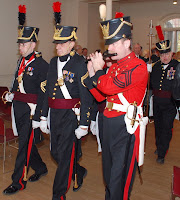Magpie coverage of Masonic Week 2010 is in the works, and will be posted serially this week.
Courtesy The Blog of Kells.
No words can describe the beauty and the extreme splendor of the richly colored initial letters, which are more profuse in the ‘Book of Kells’ than in any other manuscript. The only thing to which they can be compared is a bed of many colored crocuses and tulips or the very finest stained glass window, which they equal in beauty of coloring and rival in delicacy of ornament and drawing. The artist possessed a wonderful knowledge of the proportion of color and the distribution of his material – sienna, purple, lilac, red, pink, green, yellow, the colors most often used – and he managed the shading and tinting of the letters with consummate taste and skill. It is remarkable that there is no trace of the use of silver or gold on the vellum. Sometimes the colors are laid on in thick layers to give the appearance of enamel, and are here and there as bright and soft and lustrous as when put on fresh more than twelve hundred years ago. Even the best photographic and color reproductions give but a faint idea of the beauty of the original. Especially worthy of notice is the series of illuminated miniatures, including pictorial representations of the Evangelists and their symbols, the Blessed Virgin and the Divine Child, the temptation of Jesus, and Jesus seized by the Jews. These pictures reach their culminating point in what is, in some respects, the most marvelous example of workmanship that the world has ever produced, namely the full page monogram XPI which occurs in the text of the Gospel of St. Matthew. It is no wonder that it was for a long time believed that the ‘Book of Kells’ could have been written only by angels.
Not a bad review.
Regarding content, the Encyclopedia says the book is:
An Irish manuscript containing the Four Gospels, a fragment of Hebrew names, and the Eusebian canons, known also as the ‘Book of Columba,’ probably because it was written in the monastery of Iona to honor the saint. It is likely that it is to this book that the entry in the ‘Annals of Ulster’ under the year 1006 refers, recording that in that year the ‘Gospel of Columba’ was stolen. According to tradition, the book is a relic from the time of Columba (d. 597) and even the work of his hands, but, on paleographic grounds and judging by the character of the ornamentation, this tradition cannot be sustained, and the date of the composition of the book can hardly be placed earlier than the end of the seventh or beginning of the eighth century. This must be the book which the Welshman, Geraldus Cambrensis, saw at Kildare in the last quarter of the 12th century and which he describes in glowing terms. We next hear of it at the cathedral of Kells (Irish Cenannus) in Meath, a foundation of Columba’s, where it remained for a long time, or until the year 1541. In the 17th century Archbishop Ussher presented it to Trinity College, Dublin, where it is the most precious manuscript in the college library and by far the choicest relic of Irish art that has been preserved. In it is to be found every variety of design typical of Irish art at its best.
I have not seen this film, nor can I find solid information on any general or even limited release, which is amazing given the Oscar nomination. I really do look forward to seeing this though, because even a quick glance at the website reveals all kinds of esoteric and spiritual imagery and themes. The plot echoes countless hero myths. Its climax drips Manichean thinking. Visit the Image Gallery and behold the numerous depictions of familiar ritualistic elements, all beautifully stylized. There appears to be: sacred geometry (Fibonacci), a circle of union, a wizardly mentor/guide, a challenge to overcome fear and undertake a rough and rugged journey, and even a Jonah-like trial of being swallowed by a beast.
Of the film’s conclusion, the website suspensefully asks “Will Brendan succeed in his quest to illuminate the darkness and prove that enlightenment is the best fortification against barbarians?” Can you say “Rose Croix ritual?”
Disney trailer courtesy of Cartoon Saloon on Vimeo.
The name Brendan is the anglicized form of the Irish name Bréanainn, which in turn derives from the Welsh for “prince.” Saint Brendan, also known as “Brendan the Voyager,” was a sixth century Irish abbot who, legend says, crossed the Atlantic and reached North America with 17 other monks.






























































































